Building your own brand involves creating a unique identity and reputation for yourself or your business. It involves establishing a clear vision, mission, and values, as well as consistently presenting yourself or your business in a cohesive and professional manner. It also involves developing and promoting your unique strengths, skills, and expertise, and actively seeking out opportunities to showcase them.
Building a strong brand requires dedication, hard work, and a willingness to continuously adapt and improve. It is a long-term process that requires consistent effort and a commitment to excellence.
Establish a personal brand might sound easy. You create a website and you’re done. But the road to self-promotion is riddled with pitfalls.
If you want to see your personal brand, then step into the mirror and look. Your reflections will show you how to brand yourself. Living lives with a purpose, promote your life. Branding is living a life that feels true. And with social media, your life can reach the world. You need to find the career you want and how you want to live it. You need to live a life with an impact and a purpose. You need to live a life with a purpose then a unified vision. You’ll find your purpose, you’ll find a career, and you’ll pay it forward.
Branding is doing the things you love. This is marketing and you can do it. You are only limited by the things you’d like to do. No matter what you are doing, you take everything you can get from it. This is effort. You are doing your best. Most people don’t do enough. So you do more. You take any small step that inspires you to give more. You marry the love you have with all the actions you take, and you multiply the result.
Get the results you want. Your separation is your reintegration an encouraging reminder that you are the architect of your future. You don’t have to follow the crowd or let someone else do it for you. You can do it for yourself. You can see the path, be your own guide, and get where you want. You can imagine the life you want and make it real. YOU CAN DRAW THE FUTURE, BEFORE IT HAPPENS.
Branding is an essential component of your strategy. Here are some tips for taking your time and doing it right. Brand is simply just a name, but it’s that name that is associated with your thing. Yes, what you will do with your brand. When it exists for your business, it could be an actual name. However, it could be a variation of the name. For instance, you may have a brand name “Mr. Beast“. This would be the name of your business. This can be your brand title.
The same is applicable for your logo. A logo could be your middle initial, first name, your last name, whatever. All of these will work to your brand. You will do an excellent job applying branding to your business.
Therefore, ensure to spend time developing your branding. Allow it to be a must for your company. You can then start your company with a solid foundation! Get yourself a great logo tip that has helped lots of people make money. When designing a logo, consider whether your clients will want the logo to be oriented left to right or right to left (or vice versa). This will have a big effect on the possible size of the logo and the placement of the logo. Make sure you know everything you want to do with your logo design before starting out. The chances are that you’ll change your mind on a signing day, which ultimately means you need to start over. The process can be frustrating and time-consuming, but it will ultimately save you time and money if you need to do so in the long run. If you don’t want to start over, then make sure you plan everything out thoroughly beforehand. Don’t skip over the small details that can make a big difference in the end.
You have to come up with a catchy name for your company. If you don’t, it will be difficult for potential customers to remember or remember it without looking it up. When your name is catchy and simple, it’ll be easier for your customers to remember it. You will be able to market yourself on social media instead of having to hire a company to do it for you. You can’t put your name on a product, but you can place it on your business to make it more memorable.
You should also research where you want to sell your products and what you want your customers to purchase. You should carefully think about what you will sell in your business when you come up with your name, logo and products. As you can see from this article, there are a lot of aspects that you need to think about before starting a home business. When you are ready to jump in, think of all of these things when you start your home business.
We’ve created this guide (or) article to help you on your way.
Alright, let’s dive in!
Ten Steps for Build Your Brand:
Building a new brand essentially boils down to ten steps:
- Research your target audience and your competitors.
- Then, pick your focus and personality.
- Choose your business name.
- Write your slogan.
- Choose the look of your brand (colors and font).
- Design your brand logo.
- Apply your branding across your business.
- Build a website.
- Promote your brand.
- Engage with your audience.
For a more thorough understanding, we provide detailed explanations of each step. However, this image outlines the fundamental steps you need to follow.
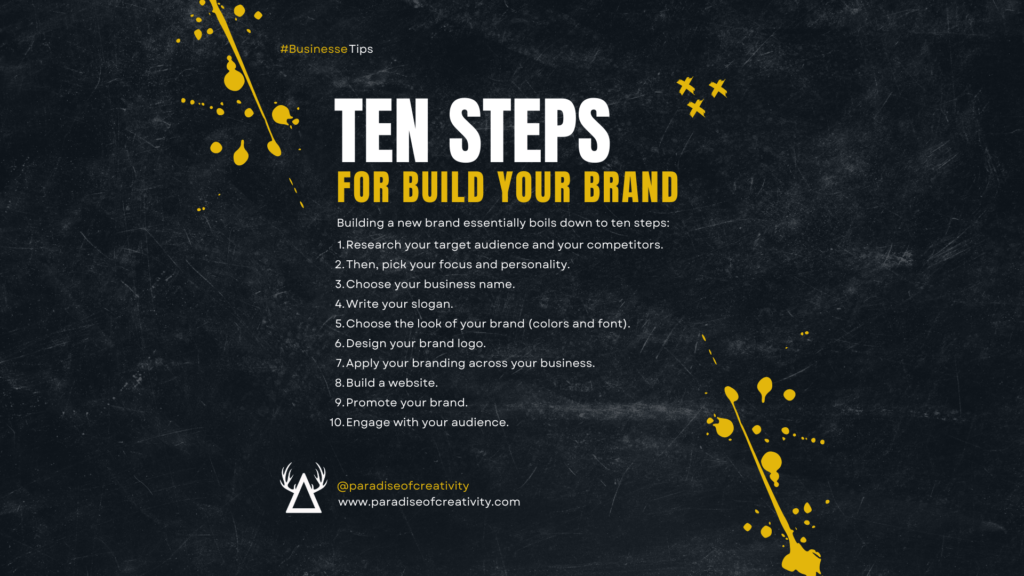
01. Research Your Target Audience and Your Competitors
Before deciding on the branding strategy for your business, it is important to thoroughly research and understand the market in which you will be operating. This includes understanding the needs and desires of your potential customers, as well as identifying your competitors and their branding strategies. By understanding the current market, you can ensure that your brand is targeting the right audience and differentiating itself from other businesses in the market.
Without this understanding, you may risk creating a brand that does not effectively appeal to your target audience or differentiate itself from competitors, leading to potential difficulties in gaining customers and establishing your business in the market. Therefore, it is crucial to take the time to research and understand the market before making any decisions about your business brand.
The first step in understanding the market is conducting customer surveys and research. Utilizing customer targeting tools and analyzing online and offline customer data allows you to adequately understand the target customer in your market. When you understand your target customer, listen to the concerns of customers with similar interests and understand their motivations. Once you have a clear understanding of what your customers want, you will have an effective means of communicating with them and presenting products that meet their expectations.
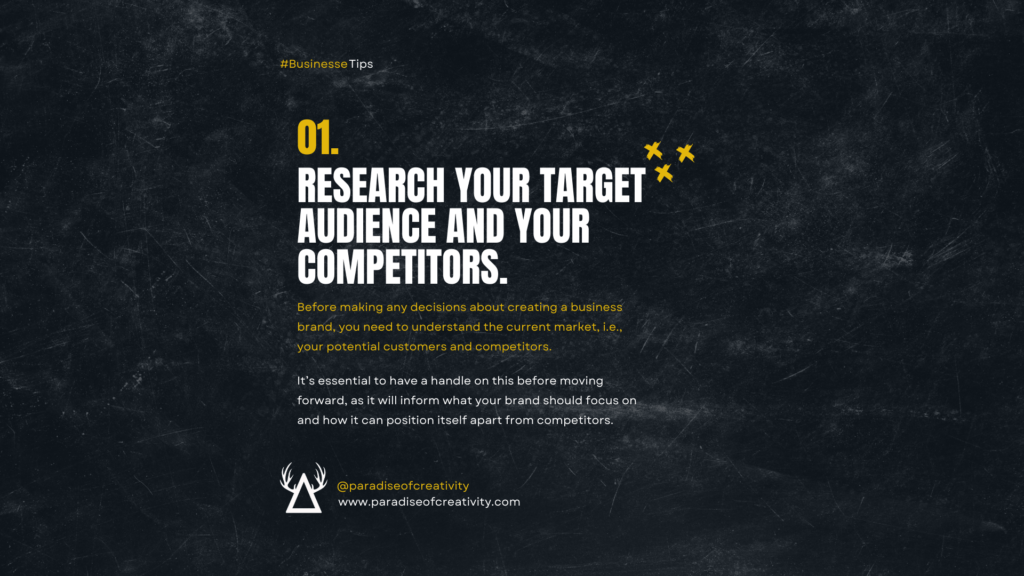
02. Pick Your Focus and Personality
When establishing a brand, it is important to recognize that you cannot appeal to every single person. Instead, it is necessary to identify a specific target audience and tailor your branding efforts towards them.
This means focusing on specific aspects of your business and highlighting those in your branding efforts. To do this, consider asking yourself the following questions:
- Who is my target audience?
- What are the unique aspects of my business that set me apart from competitors?
- What message do I want to convey through my branding efforts?
To further refine your brand focus, try engaging in some branding exercises, such as creating a brand statement or a customer avatar. A brand statement is a concise statement that defines your brand and its purpose. A customer avatar is a detailed description of your ideal customer, including their age, interests, and pain points. These exercises can help you to better understand your target audience and identify the key elements of your brand that will appeal to them.
By focusing on these elements and consistently incorporating them into all aspects of your branding efforts, you can effectively establish your brand and stand out in your industry.
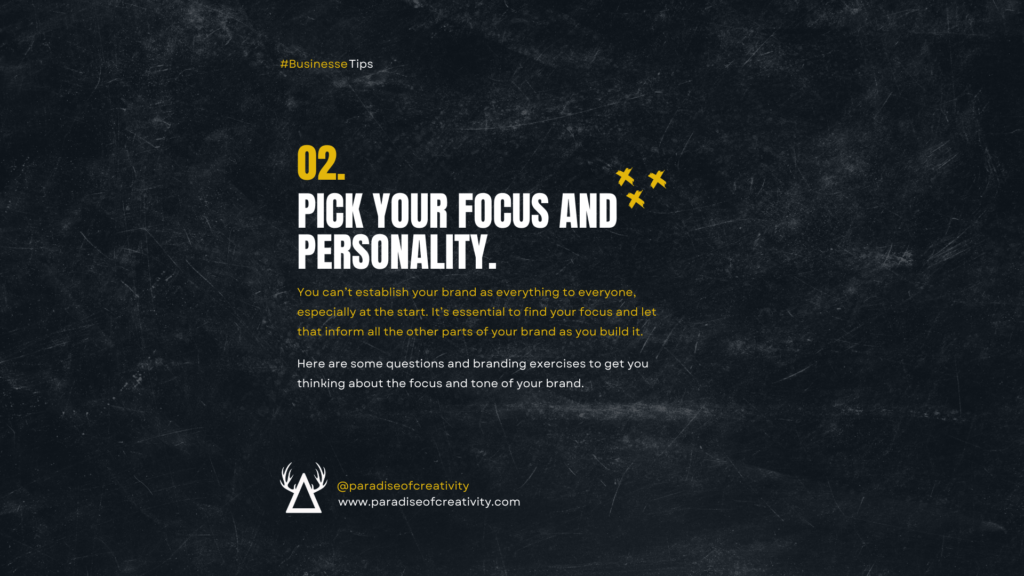
03. Choose Your Business Name
What’s in a name? Depending on the kind of business you want to start, you can make the case that your name matters very little or it matters a lot.
However, the name itself can still play a significant role in the success of your business. Here are some reasons why the name you choose for your business can be important:
- First impressions: The name of your business is often the first thing that potential customers will encounter. A well-chosen name can create a positive first impression and encourage people to explore your brand further.
- Searchability: In the digital age, it’s essential that your business can be easily found online. Choosing a name that is easy to spell and remember can help with search engine optimization and increase the chances of your business being found.
- Brand recognition: A memorable and unique name can help your business stand out in a crowded market and make it easier for customers to identify and remember your brand.
- Legal considerations: It’s essential to ensure that the name you choose for your business is not already being used by another company. Conducting a trademark search and obtaining a trademark can help protect your business name and ensure that it’s unique to your brand.
In summary, while the name of your business is just one aspect of your brand identity, it can still have a significant impact on the success of your business. Carefully considering the name you choose and ensuring it aligns with your brand values and goals can help you create a strong and memorable brand that resonates with your target audience.
As we’ve said, a brand is much more than a name. The personality, actions, and reputation of your brand identity give the name meaning in the market.

04. Write a Slogan
A catchy slogan is a powerful tool that can help you effectively communicate your brand message to your audience.
It should be brief, memorable, and descriptive, and should accurately reflect the core values and mission of your business. A good slogan can be used in a variety of contexts, such as social media bios, website headers, business cards, and other marketing materials.
It’s important to remember that a slogan is not set in stone, and you can always update or change it as you discover new angles for marketing your business. In fact, many successful companies have gone through multiple slogans over the years as they evolve and find new ways to reach their target audience.
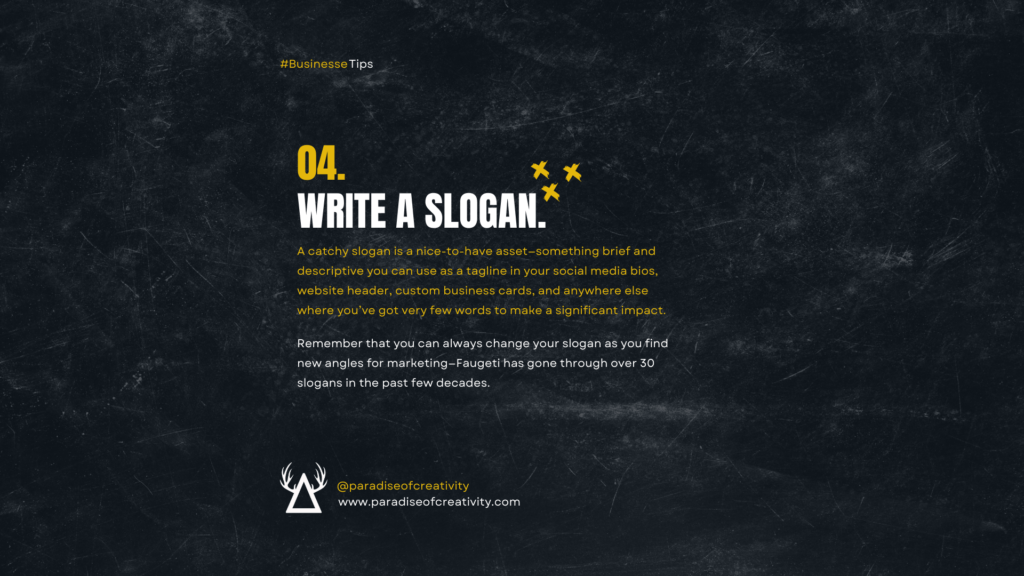
05. Choose the Look of Your Brand
Colors are an integral part of your brand’s identity. They not only contribute to the visual appearance of your brand, but they also convey a specific emotion or feeling. Therefore, it is important to carefully consider the colors you choose for your brand to ensure they accurately reflect the message you want to convey to your audience.
It is also essential to differentiate your brand from your competitors by choosing colors that are unique to your brand. Using similar colors to those used by your competitors can lead to confusion among consumers and hinder your brand’s ability to stand out in the market.
While color psychology is not a precise science, it can be a helpful tool in informing your color choices, particularly when it comes to your brand logo. Different colors can elicit different emotions and associations, so it is important to consider how each color may be perceived by your target audience. For example, blue is often associated with trustworthiness and stability, while red may be associated with passion and energy.
Overall, the colors you choose for your brand should align with the message you want to communicate and help to create a consistent visual identity across all touchpoints. By carefully considering the impact of colors on your brand, you can effectively convey the feeling you want to communicate and differentiate yourself from your competitors.
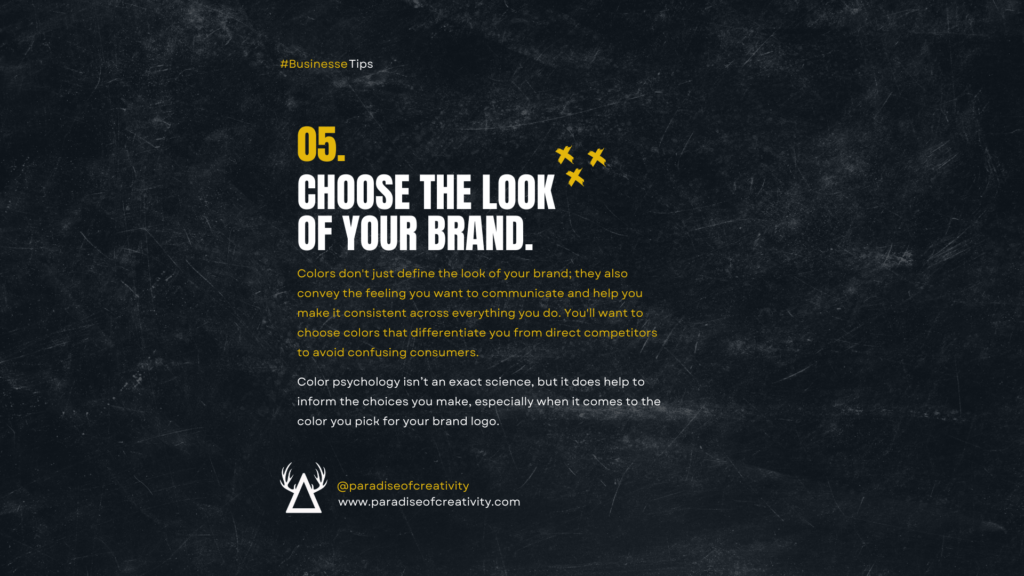
06. Design Your Brand Logo
Creating a brand logo design is a crucial step in building a new brand because it serves as the visual representation of your company. It’s the first thing that people will see and recognize when they encounter your brand, whether it’s on your website, social media, or physical products.
A good brand logo should be unique, easily identifiable, and scalable, meaning it can be used and recognized at various sizes without losing its impact. This is important because your logo will likely be used in a variety of contexts, from small social media profiles to large billboards, and you want it to be effective and recognizable in all of these situations.
In short, a brand logo is a vital component of your brand identity and it’s essential to give it the attention and care it deserves when designing it.
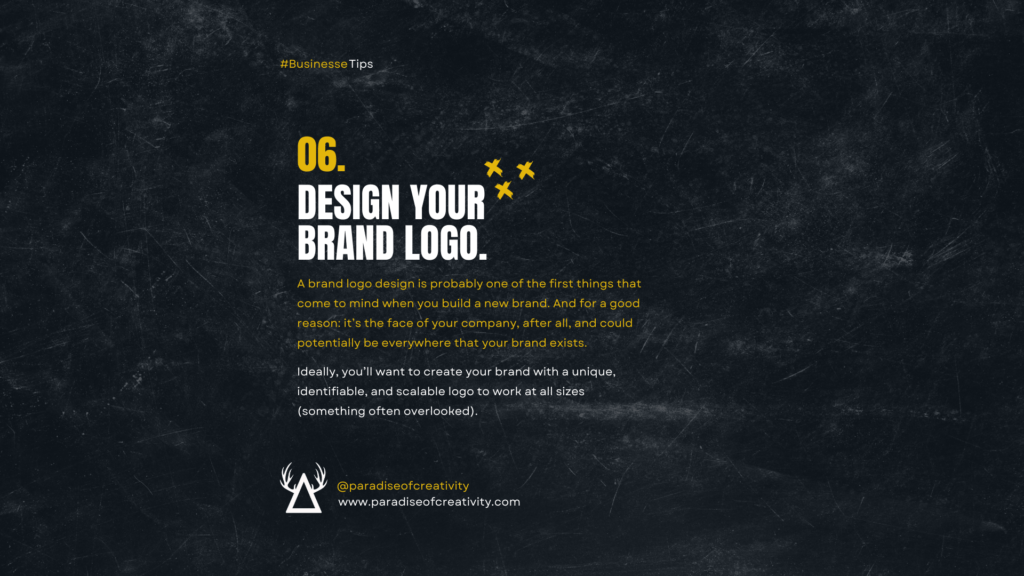
07. Apply Your Branding Across Your Business
Having a cohesive branding strategy means that every aspect of your business – from your website and social media presence to your physical storefront and marketing materials – presents a consistent message and visual identity. This helps to build trust and recognition with your customers, as they know what to expect from your business and can easily identify it in the marketplace.
Your brand story is an integral part of your branding strategy, as it conveys the values and personality of your business to your audience. It should be authentic and genuine, and should clearly communicate what makes your business unique and why customers should choose you over competitors.
Sharing your brand story with customers can be a powerful tool, as it helps to build a deeper connection with them and can differentiate your business from others in the industry. It can also help to establish credibility and trust, as customers can see that your business has a clear mission and purpose beyond just making a profit.
In summary, having a cohesive branding strategy and sharing your brand story can help your business to stand out, build trust and recognition with customers, and create a memorable and meaningful experience for them.
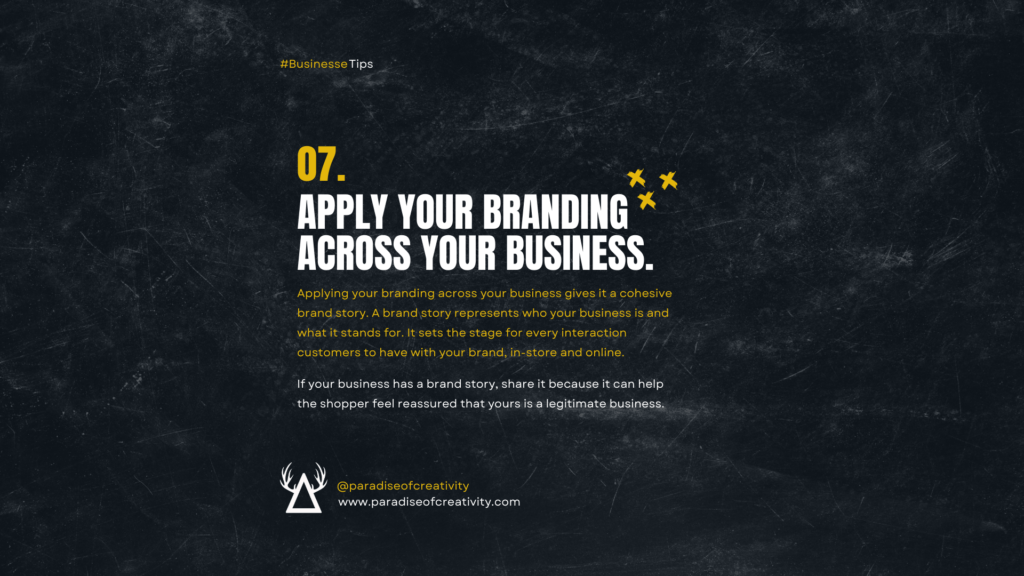
08. Build a Website
Having a website for your brand can provide a central hub for all of your online activities. It allows you to present a cohesive and consistent brand image to your audience, and gives you the opportunity to share valuable information about your products or services. A website also provides a platform for you to interact with your customers, whether through contact forms, social media integration, or online reviews.
In addition to providing a space for marketing and communication, a website can also be used as an e-commerce platform, enabling you to sell your products or services directly to your customers. This can be especially useful for small businesses, as it allows you to reach a wider audience and makes it easier for customers to purchase from you.
By building a website for your brand, you are also establishing credibility and professionalism. A website demonstrates that you are a legitimate business with a dedicated online presence, which can be a key factor in attracting and retaining customers. In today’s digital age, having a website is essential for any brand looking to succeed in the competitive online marketplace.
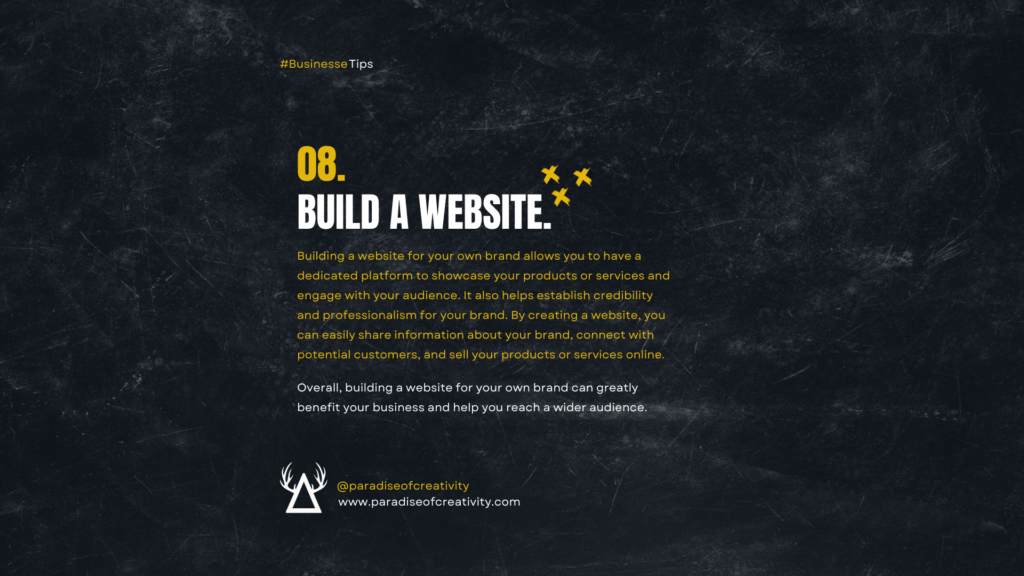
09. Promote Your Brand
Promoting your brand effectively requires a strategic and consistent approach. Here are some tips to help you get the word out about your business:
- Develop a clear brand message and values: Before you start promoting your brand, it’s important to know what makes you unique and what you stand for. This will help you create a cohesive brand identity that resonates with your target audience.
- Use social media to your advantage: Social media platforms are a great way to reach a large audience quickly. Use platforms like Facebook, Instagram, and Twitter to share your brand message and engage with your followers.
- Create engaging content: Whether it’s blog posts, videos, or podcasts, creating high-quality content is an important part of building a brand. Use your content to showcase your expertise, solve problems, and provide value to your audience.
- Use email marketing to connect with customers: Email marketing is a powerful way to nurture relationships with customers and keep them informed about your business. Use newsletters, promotional emails, and other types of email marketing to stay top-of-mind with your audience.
Ultimately, the goal is to get your brand in front of as many people as possible, and to make a positive impression that leads to increased brand awareness and sales.
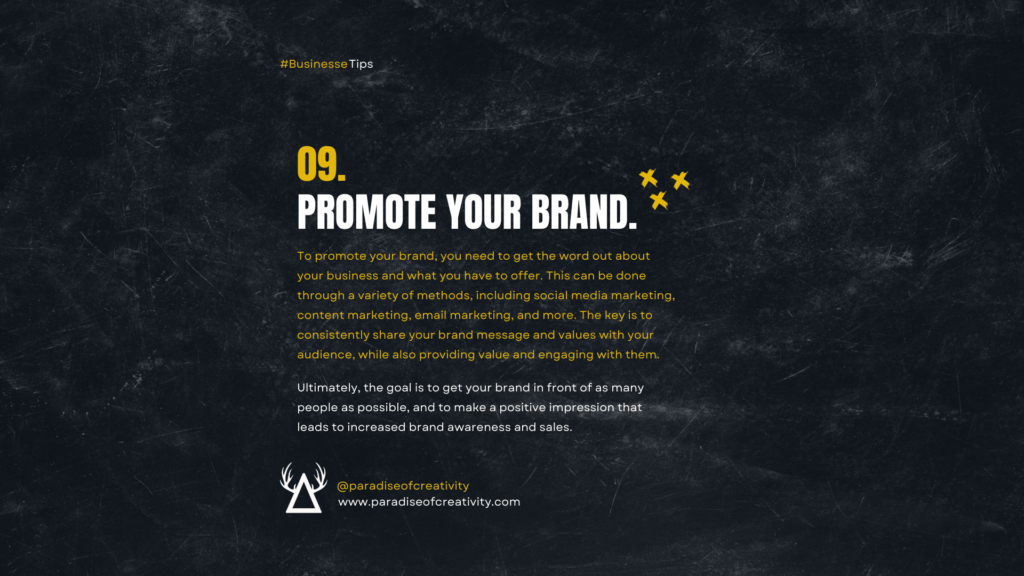
10. Engage with Your Audience
Engaging with your audience means actively seeking to involve them in the conversation or discussion around your content or topic. This can be done through various methods such as asking questions, inviting feedback or opinions, and responding to comments and interactions. By actively communicating with your audience and seeking their involvement, you can build a sense of community and create a stronger connection between you and your audience.
This can be especially important for businesses or organizations as it can help to build loyalty and trust among your audience. Engaging with your audience can also help you to better understand their needs, preferences, and concerns, which can be valuable information for improving your products or services.
In short, engaging with your audience is an important way to build a strong and meaningful relationship with them and create a sense of community around your content or topic.
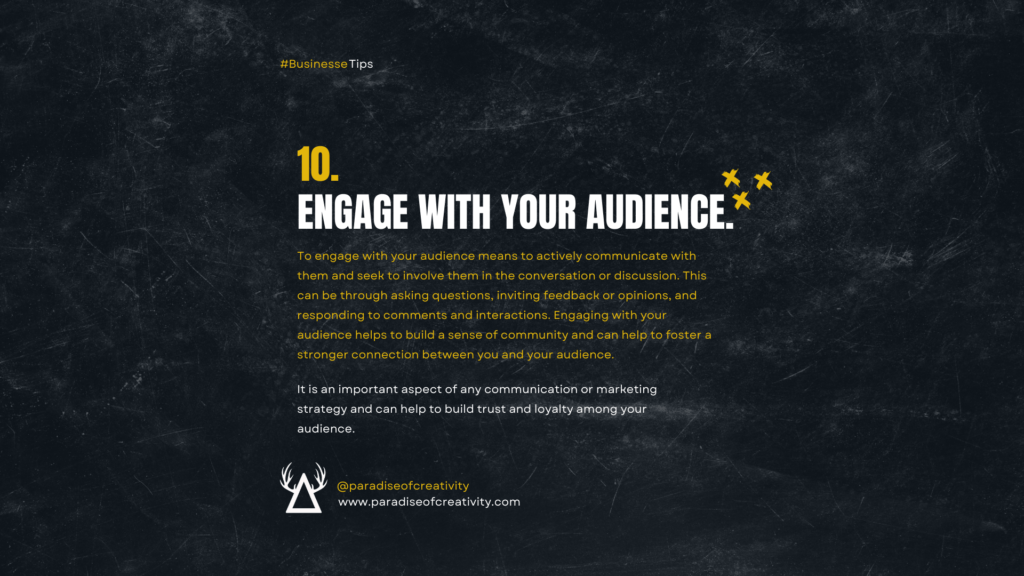
That’s a wrap!
Here are some additional tips for ensuring that your brand looks perfect and helps you get more engagement:
- Use high-quality visuals: Whether it’s your logo, website, or social media posts, using high-quality visuals is crucial for creating a professional and cohesive brand image. Make sure to use clear and visually appealing images, and avoid using low-quality or blurry images.
- Consistency is key: Consistency is crucial for building a strong brand. This means using the same colors, fonts, and design elements across all of your marketing materials. It also means being consistent in your messaging and tone of voice.
- Experiment with new tactics: While it’s important to maintain consistency in your branding, it’s also important to be open to trying new things. Experimenting with new tactics, such as using new social media platforms or running promotions, can help you reach a wider audience and increase engagement.
I hope these tips are helpful! Let me know if you have any other questions.
Thank you.

